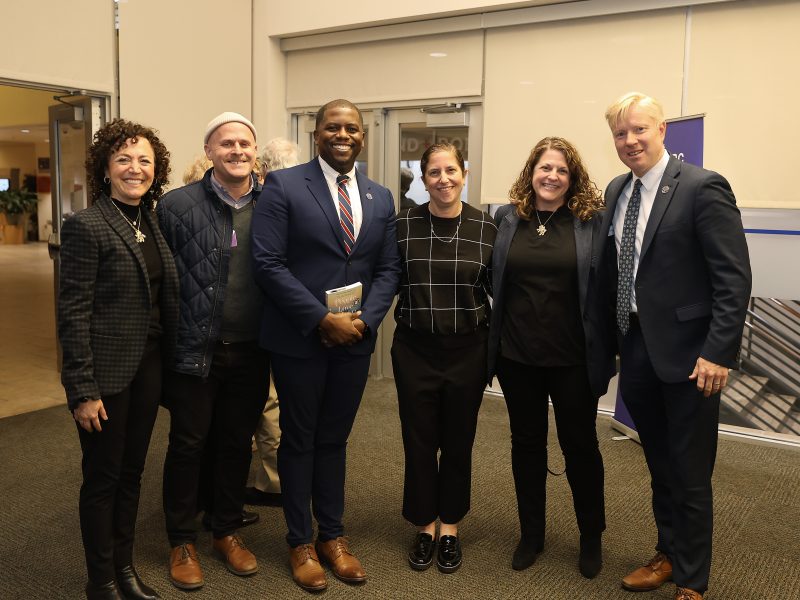Danielle V. Minson — Raising the Bar

March 22 Update: Reflecting on Our JCRC Annual Meeting
Dear Friends,
This Wednesday, over 200 people from our Jewish community and alliescame together at our Jewish Community Relations Council (JCRC) Annual Meeting. We shared our collaborative work in education, security, and advocacy over the past year, demonstrating how partnerships amplify our efforts. A highlight of the meeting was Dara Horn, the acclaimed author of People Love Dead Jews. Horn’s book explores the dynamics within non-Jewish societies that often only honor or celebrate Jews when they appear powerless or are in fact dead, rather than active, contributing members of society.
Her speech was powerful. Here are a few takeaways I had heard before, but with slightly different spins:
- Jews as the Original ‘Other’: In her speech, Horn humorously but pointedly commented on how Jewish monotheism distinguished Jews in a polytheistic ancient world, branding them as the original outsiders. As she said, “The Jewish brand’s uncoolness traces back to the ancient Near East, where societies worshipped visible deities, and here were the Jews, aligning themselves with a bossy, unsexy, invisible G-d—the quintessential uncool people.”
- Identity Boxes: Horn wittily pointed out that Jews are more than a religious group: “Jews predate the modern concept of race, nationality, and even the concept of religion itself… Every non-Jewish society has tried to fit Jews into what identity boxes that society knows best. And here’s the problem: Jews predate the box.” It’s both clarifying and familiar to hear that Jews encompass a unique blend of culture, tradition, and history that cannot be fully captured by contemporary labels of religion or ethnicity.
- Two Types of Antisemitism: In my Wexner class, we talked about ‘Hanukkah Jews’ and ‘Purim Jews’ — how we as a community deal with challenges. ‘Hanukkah Jews’ show resilience, while ‘Purim Jews’ face threats head-on. I hadn’t heard it in the context of two types of antisemitism.
- Hanukkah Antisemitism focuses on cultural assimilation and the subtle pressures to erase Jewish identity. This form prefers Jewish invisibility, subtly coercing Jews to abandon their uniqueness and blend into the dominant culture.
- Purim Antisemitism is overtly aggressive, aiming for physical harm or outright elimination of Jews, as vividly depicted in the Purim story with Haman’s plot to kill the Jews.
- Jewish Self-Erasure: Antisemitism, both the Hanukkah and the Purim kind, can push Jews towards hiding their identity. This might mean altering how they act, what they believe, or even their names, just to fit in and avoid trouble.
Diving into Horn’s book, her chapter on Ellis Island resonated with me, sparking a real ‘aha’ moment. She debunks the myth of Ellis Island’s name changes, revealing that many Jewish immigrants altered their names by choice, through legal petitions, often years after arriving in America. This was a strategy to counter the pervasive antisemitism that prevented them from getting jobs and fully integrating into society—reflecting not a mandated erasure, but a conscious decision to adapt and survive in a new land.
When I discussed this with my parents, they remained skeptical. Despite Horn’s research, they cling to the belief that my grandfather’s last name was changed at Ellis Island when our family emigrated from the Soviet Union, and on my mother’s Armenian side, first names were altered before emigrating—these are stories passed down through generations. Who can say what the real truth is! But if I believe Horn’s perspective, the name changes were not a loss but a deliberate act of resilience, a decision made by my grandparents to shield future generations from discrimination.
Horn believes in the power of education. By teaching both Jews and others about our true history and culture, we honor our past and strengthen our identity, and make us more “human” and less “other.”
In line with Horn’s call for an educational response to antisemitism, this week we also educated Cincinnatians on the disturbing display of two large “Save Ireland from the Jews” banners. Rabbi Ari Jun, our JCRC Director, and I expressed our stance in an Enquirer op-ed piece titled “United Against Hate: How Cincinnati Stands Together.” Please read our op-ed and share your thoughts. Read here.
As we celebrate Purim, I leave you with Horn’s uplifting words: “In every generation, there are those who rise up against us, but it is our spirit, our culture, and our unwavering faith that sustain us.”
Chag Purim Sameach – wishing you a joyful and festive Purim!
Danielle V. Minson
CEO
Jewish Federation of Cincinnati

